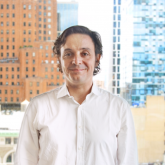Fame-seeking mass shooters more likely to plan ‘surprise’ attacks, and the novelty of their locations and targets brings added fame

Mass shooters pursuing fame often plan their attacks as “surprises," carefully crafting them in ways that set them apart from previous incidents, which makes them uniquely challenging to prevent.
That is a key finding in a groundbreaking new study from NYU Tandon School of Engineering, about the subset of mass shooters in the U.S. for whom notoriety is a primary objective. The study is published in the Proceedings of the National Academy of Sciences (PNAS).
Led by Maurizio Porfiri, NYU Tandon Institute Professor and Director of the Center for Urban Science and Progress (CUSP), a team of researchers collected and analyzed data from 189 mass shootings between 1966 and 2021, and found that fame-seekers — as opposed to those predominantly motivated by personal grievance or revenge, for example — planned their crimes around the novelty of the location and targets.
This type of deviation from historical precedent did, in fact, boost the shooters’ fame, the research revealed.
“Previously, it was believed that lethality — how many people killed — was the main contributor to mass shooters’ fame. Our study found that ‘surprise’ creates fame even when controlling for lethality,” said Porfiri. “Fame-seeking mass shooters are not necessarily attempting deadlier shootings by maximizing surprise. Rather, the data found no relationship between surprise and lethality, either achieved by the shooters in terms of death and injury toll, or sought after by bringing more or deadlier weapons. It is likely that pursuing surprising attacks is perceived as an independent path to fame for these types of shooters.”
Attacks by fame-seekers were about three times more surprising than those from non-fame-seekers, based on a metric called "surprisal” that measures how much an attack deviated from preceding mass shootings in terms of the location and targets chosen. Surprisal is a mathematical concept borrowed from the field of information theory, a key engineering area that has a wide range of applications from cryptography to statistical inference, urban science, and robotics.
Eight out of the ten most famous mass shootings were perpetrated by fame-seekers, the researchers found. To assess fame, researchers relied on Wikipedia traffic data for pages related to each incident — which indicates how much the public searches for information about the event — rather than the quantity of media coverage an incident generates, a traditional fame measure. Shooters' own documented comments about desiring fame from their acts established their fame-seeking status.
This new insight about the novelty of fame-seeking mass shooters’ attacks adds urgency to two important preventative strategies, red flag laws and how the media covers these atrocities, said Porfiri.
Strong red flag laws ratchet up the legal ability to restrict firearm access for people exhibiting threatening behavior. “Fame seekers frequently make their intentions known prior to acting, making red flag laws crucial to prevent that sort of crime,” said Porfiri, who pointed out that increasing security at “normal” mass shooting locations will not stop fame seekers who expressly avoid committing their crimes in those places.
In fact, the media establishes what is “normal” by including precise details about the locations and targets in news stories about mass shootings, said Porfiri, creating a pattern that fame seekers work against. Porfiri said that although reducing details in media coverage of mass shootings could play a role in reducing fame-seeking attacks, additional research would be needed to confirm optimal reporting strategies.
The NYU Tandon research team that conducted this research includes Ph.D. candidate Rayan Succar, Postdoctoral Fellow Roni Barak Ventura, former high-school intern Maxim Belykh, and undergraduate student Sihan Wei.
The study contributes to Porfiri’s ongoing data-based research related to U.S. gun prevalence and violence, which he is pursuing under a $2 million National Science Foundation grant he received in 2019 to study the “firearm ecosystem” in the United States. Previous projects focused on factors that prompt gun purchases, state-by-state gun ownership trends, and forecasting monthly gun homicide rates.
As the director of CUSP, an interdisciplinary research center at NYU Tandon, Porfiri also advances the Center’s focus on leveraging New York City as a testing ground for a wide range of solutions to enhance the quality of life for urban communities worldwide. Urban-focused research and teaching are among the seven “areas of excellence” that define NYU Tandon’s institutional priorities. Last month, Environmental Microbiome published a paper from CUSP faculty member Elizabeth Henaff, about her pioneering study revealing that urban honeybee hives provide vital information about cities’ microbiome, some of which pose threats to the health of humans who live there.
About the New York University Tandon School of Engineering
The NYU Tandon School of Engineering is home to a community of renowned faculty and undergraduate and graduate students united in a mission to understand and create technology that powers cities, enables worldwide communication, fights climate change, and builds healthier, safer, and more equitable real and digital worlds. The school’s culture centers on encouraging rigorous, interdisciplinary collaboration and research; fostering inclusivity, entrepreneurial thinking, and diverse perspectives; and creating innovative and accessible pathways for lifelong learning in STEM, from K12 to executive education and new advances in digital learning.
NYU Tandon dates back to 1854, the founding year of both the New York University School of Civil Engineering and Architecture and the Brooklyn Collegiate and Polytechnic Institute. Those institutions evolved independently before merging in 2014 to create what is now known as NYU Tandon. Located in the heart of Brooklyn, NYU Tandon is a vital part of NYU's New York campus and unparalleled global network. For more information, visit engineering.nyu.edu.





